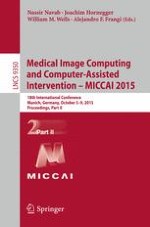2015 | OriginalPaper | Buchkapitel
Computer-Aided Pulmonary Embolism Detection Using a Novel Vessel-Aligned Multi-planar Image Representation and Convolutional Neural Networks
verfasst von : Nima Tajbakhsh, Michael B. Gotway, Jianming Liang
Erschienen in: Medical Image Computing and Computer-Assisted Intervention -- MICCAI 2015
Aktivieren Sie unsere intelligente Suche, um passende Fachinhalte oder Patente zu finden.
Wählen Sie Textabschnitte aus um mit Künstlicher Intelligenz passenden Patente zu finden. powered by
Markieren Sie Textabschnitte, um KI-gestützt weitere passende Inhalte zu finden. powered by
Computer-aided detection (CAD) can play a major role in diagnosing pulmonary embolism (PE) at CT pulmonary angiography (CTPA). However, despite their demonstrated utility, to achieve a clinically acceptable sensitivity, existing PE CAD systems generate a high number of false positives, imposing extra burdens on radiologists to adjudicate these superfluous CAD findings. In this study, we investigate the feasibility of convolutional neural networks (CNNs) as an effective mechanism for eliminating false positives. A critical issue in successfully utilizing CNNs for detecting an object in 3D images is to develop a “right” image representation for the object. Toward this end, we have developed a vessel-aligned multi-planar image representation of emboli. Our image representation offers three advantages: (1) efficiency and compactness—concisely summarizing the 3D contextual information around an embolus in only 2 image channels, (2) consistency—automatically aligning the embolus in the 2-channel images according to the orientation of the affected vessel, and (3) expandability—naturally supporting data augmentation for training CNNs. We have evaluated our CAD approach using 121 CTPA datasets with a total of 326 emboli, achieving a sensitivity of 83% at 2 false positives per volume. This performance is superior to the best performing CAD system in the literature, which achieves a sensitivity of 71% at the same level of false positives. We have further evaluated our system using the entire 20 CTPA test datasets from the PE challenge. Our system outperforms the winning system from the challenge at 0mm localization error but is outperformed by it at 2mm and 5mm localization errors. In our view, the performance at 0mm localization error is more important than those at 2mm and 5mm localization errors.
